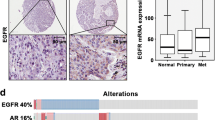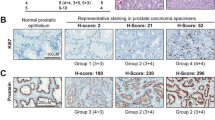Abstract
Janus kinases (JAK)/signal transducers and activator of transcription (STAT) pathway is activated constitutively in prostate cancer (PCa). Despite previous reports implying a role of this pathway in the development of clinical hormone-refractory PCa, the correlation of pathway members with the clinicopathologic features and prognosis of patients with PCa has not been elucidated. To address this problem, pJAK-1Tyr1022/1023 and pSTAT-3Tyr705 were evaluated by immunostaining in needle biopsies of the prostate from 202 PCa patients treated by definitive therapy (105 cases) or hormonal therapy (97 cases). The correlation of two protein expression with the clinicopathologic features and the prognosis of PCa were subsequently assessed. The expression levels of pJAK-1Tyr1022/1023 and pSTAT-3Tyr705 were both positively correlated with Gleason score and clinical stage of patients with PCa. Their expression was also significantly higher in patients with biochemical (prostate-specific antigen, PSA) failure than that in those with no PSA failure (both P < 0.001). In all patients, the recurrence-free survival (RFS) rates were significantly higher in those with low pJAK-1Tyr1022/1023 and pSTAT-3Tyr705 expression than that in those with high expression (both P < 0.001). Moreover, for patients treated by definitive or hormonal therapy, the RFS rates in those with lower pJAK-1Tyr1022/1023 (P < 0.001 and 0.012, respectively) and pSTAT-3Tyr705 expression (P < 0.001 and 0.015, respectively) were significantly higher than in those with higher expression. Cox multivariate analysis showed that the expression levels of pJAK-1Tyr1022/1023 (P = 0.002) and pSTAT-3Tyr705 (P = 0.005) were prognostic factors for PCa in addition to extraprostatic extension (P = 0.026) and Gleason score (P = 0.018). The results of pJAK-1Tyr1022/1023 and pSTAT-3Tyr705 immunostainings in needle-biopsy specimens are prognostic factors for PCa.


Similar content being viewed by others
Reference
Kehinde EO, Maghrebi MA, Anim JT (2008) The importance of determining the aggressiveness of prostate cancer using serum and tissue molecular markers. Can J Urol 15:3967–74
Hochreiter WW (2008) The issue of prostate cancer evaluation in men with elevated prostate-specific antigen and chronic prostatitis. Andrologia 40:130–3
Loeb S, Catalona WJ (2008) What to do with an abnormal PSA test. Oncologist 13:299–305
Bolli R, Dawn B, Xuan YT (2003) Role of the JAK-STAT pathway in protection against myocardial ischemia/reperfusion injury. Trends Cardiovasc Med 13:72–9
Booz GW, Day JN, Baker KM (2002) Interplay between the cardiac renin angiotensin system and JAK-STAT signaling: role in cardiac hypertrophy, ischemia/reperfusion dysfunction, and heart failure. J Mol Cell Cardiol 34:1443–53
Gross ER, Hsu AK, Gross GJ (2006) The JAK/STAT pathway is essential for opioid-induced cardioprotection: JAK2 as a mediator of STAT-3, Akt, and GSK-3β. Am J Physiol Heart Circ Physiol 291:827–34
Kandalam U, Clark MA. Angiotensin II activates JAK2/STAT-3 pathway and induces interleukin-6 production in cultured rat brainstem astrocytes, Regul Pept doi:10.1016/j.regpep.2009.09.001
Darnell JE Jr (1997) STATs and gene regulation. Science 277:1630–5
Levy DE, Darnell JE Jr (2002) Stats: transcriptional control and biological impact. Nat Rev Mol Cell Biol 36:51–62
Calo V, Migliavacca M, Bazan V (2003) STAT proteins: from normal control of cellular events to tumorigenesis. J Cell Physiol 197:157–68
Barton BE, Karras JG, Murphy TF, Barton A, Huang HF (2004) Signal transducer and activator of transcription 3 (STAT3) activation in prostate cancer: Direct STAT3 inhibition induces apoptosis in prostate cancer lines. Mol Cancer Ther 3:11–20
Agarwal C, Tyagi A, Kaur M (2007) Silibinin inhibits constitutive activation of Stat3, and causes caspase activation and apoptotic death of human prostate carcinoma DU145 cells. Carcinogenesis 28:1463–70
Tam L, McGlynn LM, Traynor P (2007) Expression levels of the JAK/STAT pathway in the transition from hormone-sensitive to hormone-refractory prostate cancer. Br J Cancer 97:378–83
Schroder FH, Hermanek P, Denis L (1992) classification of prostate cancer. Prostate Suppl 4:129–38
Gleason DF, Mellinger GT (1974) Prediction of prognosis for prostatic adenocarcinoma by combined histological grading and clinical staging. J Urol 111:58–64
Wang L, Guojun Wu, Lei Yu (2006) Inhibition of CD147 expression reduces tumor cell invasion in human prostate cancer cell line via RNA interference. Cancer Biol Ther 5:608–14
Pulukuri S, Patel J, Estes N (2007) Matrix metalloproteinase-1 (MMP-1) expression and biological signiWcance in the progression of prostate cancer (abstract). In: American Association for Cancer Research Annual Meeting: proceedings 14–18
Kakehi Y (2003) Watchful waiting as a treatment option for localized prostate cancer in the PSA era. Jpn J Clin Oncol 33:1–5
Lacronique V, Boureux A, Valle VD (1997) A TEL-JAK2 fusion protein with constitutive kinase activity in human leukemia. Science 278:1309–12
Alvarez JV, Greulich H, Sellers WR (2006) Signal transducer and activator of transcription 3 is required for the oncogenic effects of non–small-cell lung cancer–associated mutations of the epidermal growth factor receptor. Cancer Res 66:3162–8
Xiong H, Zhang ZG, Tian XQ (2008) Inhibition of JAK1, 2/STAT3 signaling induces apoptosis, cell cycle arrest, and reduces tumor cell invasion in colorectal cancer cells. Neoplasia 10:287–97
Ram PT, Horvath CM, Lyengar R (2000) Stat3-mediated transformation of NIH-3T3 cells by the constitutively active Q205L Gαo protein. Science 287:142–4
Tu Y, Zhong Y, Fu J. Activation of JAK/STAT signal pathway predicts poor prognosis of patients with gliomas. Med Oncol. In press
Wang T, Niu G, Kortylewski M (2004) Regulation of the innate and adaptive immune responses by Stat-3 signaling in tumor cells. Nat Med 10:48–54
Cozzi PJ, Wang J, Delprado W et al (2005) MUC1, MUC2, MUC4, MUC5AC and MUC6 expression in the progression of prostate cancer. Clin Exp Metastasis 22:565–73
Seitz C, Djavan B (2006) Biological markers of prostate cancer. Ann Urol (Paris) 40:329–35
Author information
Authors and Affiliations
Corresponding author
Rights and permissions
About this article
Cite this article
Liu, X., He, Z., Li, Ch. et al. Correlation Analysis of JAK-STAT Pathway Components on Prognosis of Patients with Prostate Cancer. Pathol. Oncol. Res. 18, 17–23 (2012). https://doi.org/10.1007/s12253-011-9410-y
Received:
Accepted:
Published:
Issue Date:
DOI: https://doi.org/10.1007/s12253-011-9410-y




